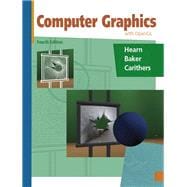Computer Graphics with OpenGL, 4/e is appropriate for junior-to graduate-level courses in computer graphics.
Assuming no background in computer graphics, this junior-to graduate-level course presents basic principles for the design, use, and understanding of computer graphics systems and applications. The authors, authorities in their field, offer an integrated approach to two-dimensional and three-dimensional graphics topics. A comprehensive explanation of the popular OpenGL programming package, along with C++ programming examples illustrates applications of the various functions in the OpenGL basic library and the related GLU and GLUT packages.









